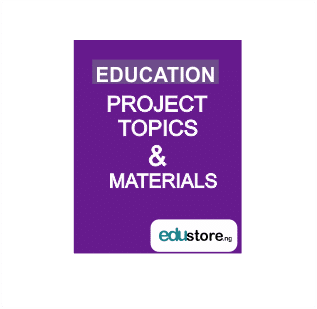AN ASSESSMENT OF TEACHERS’ KNOWLEDGE OF TEST CONSTRUCTION PROCEDURE IN CHEMISTRY OBJECTIVE TEST IN SENIOR SECONDARY SCHOOLS
Testing has always been an integral part of the educational system since its inception. The concept (testing) can be viewed as a set of tasks presented to a person, the performance of which depends on the possession of a particular body of knowledge and skill. The emphasis being laid on continuous assessment in Nigeria’s educational system has therefore given a boost to the testing system in our educational institutions. The National Policy on Education (2004) emphasizes the importance of continuous assessment by stating that “Educational Assessment and Evaluation will be liberalized by basing them in whole or in part on continuous assessment of the progress of the individualâ€. This implies that teachers should assess both the entry and terminal behaviour of the students in the subject being taught as this will reveal the progress made by the individual student during the course.
Continuous assessment has been presented as a revolutionary approach to assessment (Yoloye, 1984), (Firth and Macintosh, 1984) and (Ughanadu, 1994). They claim that, continuous assessment is a more valid form of assessment than conventional examination or traditional assessment method. The superiority of continuous assessment is based on the fact that, continuous assessment can sample a much wider range of skills and abilities inherent in a course of study. Continuous assessment in many respects offers a challenge to both the learner and the teacher of science.
A Federal Ministry of Education Handbook (1980) portrays continuous assessment as a method of finding out what the students have gained from the learning experiences with respect to knowledge, thinking, reasoning, character development, industry, etc. Science subjects and chemistry in particular, like many of the educational disciplines, provide unique opportunities for the application of continuous assessment. There are three major areas (components) of any science subject which lend themselves to assessment: cognitive (theoretical) aspects; psychomotor (manipulative) aspects and affective (attitude) aspects.
With the advent of continuous assessment, there has been an increasing need of classroom teachers to prepare and administer tests in order to obtain certain vital information about what has been done during the teaching – learning process. In this regard therefore, testing can be used as a teaching instrument and as an instrument of assessment. These purposes are essential in the teaching of chemistry. When used as a teaching instrument, the outcome of a testing exercise provides a quick feedback on what learning has taken place in the classroom. As an aid to teaching, testing finds out problems with teaching strategies adopted, or detects weaknesses and strengths of the students taught. In this instance, testing serves a diagnostic function.
As an instrument of assessment, a test measures achievement, predicts performances and aids in selection exercises. Testing therefore, provides useful information for decision making about students, teachers and the programme.
For ascertaining the gains of the instruction process, achievement tests are administered by teachers. These according to Ughamadu, Onwuegbu and Osunde (1991) are tests that measure the extent to which a person has acquired certain information, mastered certain skills, usually as a result of specific instruction. In most of our schools, teachers set and administer most of these tests in the bid to find out how much their students have gained in the course of their instructions. These tests are in most cases not scrutinized for validity and reliability which are the most incompromisable requirements for a good test. According to Osunde (2000) “Teacher – made tests are generally deficient in numerous ways. The most common fault is related to ineffective communicationâ€.
- For Reference Only: Materials are for research, citation, and idea generation purposes and not for submission as your original final year project work.
- Avoid Plagiarism: Do not copy or submit this content as your own project. Doing so may result in academic consequences.
- Use as a Framework: This complete project research material should guide the development of your own final year project work.
- Academic Access: This platform is designed to reduce the stress of visiting school libraries by providing easy access to research materials.
- Institutional Support: Tertiary institutions encourage the review of previous academic works such as journals and theses.
- Open Education: The site is maintained through paid subscriptions to continue offering open access educational resources.





